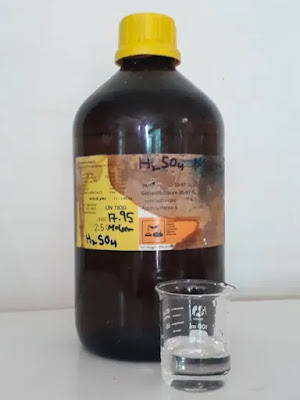Contents
hide
CHEMICAL PRODUCT IDENTIFICATION
- Product Namely: Sulfuric Acid. 06 M – 12 M (Concentrated)
- Signal Sign: DANGER!
- Thorough Sulfuric Acid SDS – Safe handling with detailed instructions.
HAZARDS IDENTIFICATION
- It damages & burns the skin and eyes severely.
- It produces irritation or corrosion to the skin.
- Do not inhale spray, fumes, or mist.
- It is harmful if ingested or breathed in.
- It is harmful to the aquatic environment.
- The heat created while dissolved in water is high.
COMPOSITION, INFORMATION ON INGREDIENTS
| Name of Component | CAS Number | Formula | Formula Weight | Concentration |
|---|---|---|---|---|
| Sulfuric acid | 7664-93-9 | H2SO4 | 98.079 g/mol | 32-96% |
| Water | 7732-18-5 | H2O | 18.01528 g/mol | 4-68% |
FIRST-AID MEASURES
- If you feel unwell, contact a doctor.
- If inhaled: Remove the victim to fresh air & keep them at rest in a breathing-friendly position.
- If in the eyes: Carefully rinse for a few minutes(20 minutes) with water. If contact lenses are present & simply possible to remove, do so. Rinsing continues.
- If on hair & skin: Remove any contaminated garments right away. Wash your skin with water.
- Before reusing, wash any compromised clothing.
- If swallowed: first clean your mouth & go to the doctor.
- Don’t induce vomiting.
FIRE-FIGHTING MEASURES
- It is non-flameable & non combustible sol.
- Use carbon dioxide, foam, dry chemicals, or water in case of fire.
- Decomposition when heated can release poisonous gases.
- The Sulfur’s oxides may be formed in a fire.
ACCIDENTAL RELEASE MEASURES
- Ventilate the area.
- Use sand or another inert absorbent material to confine the spill, neutralize it with calcium hydroxide or sodium bicarbonate, and then deposit the spilled item in a sealed bag or container.
- To prevent any kind of material damage, soak up spills.
- Remember that sulfuric acid spills are particularly slippery.
HANDLING & STORAGE
- Except for nitric acid, store with acids.
- Keep far from any water source in an acid-specific cabinet.
- Only keep it in the original container.
- Keep the container firmly shut.
- Use only in well-ventilated areas or under a hood.
EXPOSURE CONTROLS, PERSONAL PROTECTION
- Wear safety gear, including gloves, clothes, & eye protection.
- After handling, carefully wash your hands.
- Use only in well-ventilated areas or under a hood.
- Guidelines for exposure be OSHA’s PEL is 1 mg/m3, ACGIH’s TLV is 0.2 mg/m3 (thoracic fraction), and IDLH is 15 mg/m3.
PHYSICAL & CHEMICAL PROPERTIES
- Appearance: It is a dense, colorless & oily liquid.
- Solubility: It is water miscible; produces a lot of heat.
- Temperatture of decompositon:
- Boiling point: 290°C – 337°C.
- Melting point: 10.3°C.
- pH: <1>.
- Specific gravity(density): 1.84 g/cm³.
- Vapor density: 3.38.
STABILITY & REACTIVITY
- Nitrates, carbonates, peroxides, chlorates & reducing agents should all be kept away from the interaction as should strong bases, organic compounds, finely powdered metals, and reducing agents.
- aggressively reacts with water.
- Never put water in acid, always the other way around.
- It has satisfactory shelf life if properly stored.
TOXICOLOGICAL INFORMATION
- Acute effects: All body tissues are corrosive, and the respiratory tract is severely irritated.
- Chronic effects: It causes cancer, and tooth erosion, and is harmful to the nose, throat, & lungs.
- Targeted organs: It targets the respiratory system, skin, teeth, and eyes.
- LD50 for ORL-RAT: 2140 per mg/kg.
- LC50 for IHL-RAT: 510mg/m3/2, per hour.
- LD50 for SKN-RBT: N/A.
ECOLOGICAL INFORMATION
- Fish(aquatic life): 49 milligrams/Liter; 48 hours; TLm (for tap water at 20°C) for bluegill & sunfish.
DISPOSAL CONSIDERATIONS
- Dispose of in accordance with local, state, & federal rules or laws.
TRANSPORT INFORMATION
- Name of shipment: Acid sulfuric. Corrosive, class 8, is the hazard. UN 1830 is its number.
REGULATORY INFORMATION
- TSCA and EINECS listings (231-639-5). RCRA coding: D003, RCRA coding: D002.
OTHER INFORMATION
This Safety Data Sheet (SDS) is intended as a guide & is based on data & tests that are likely to be reliable. I don’t guarantee the data’s correctness or completeness & I’m not responsible for any resulting losses. The information is only being provided for your review, research, & verification. I DO NOT ASSUME RESPONSIBILITY AND EXPRESSLY DISCLAIM LIABILITY FOR LOSS, DAMAGE, OR EXPENSE RESULTING FROM OR IN ANY WAY CONNECTED WITH THE HANDLING, STORAGE, USE, OR DISPOSAL OF THIS PRODUCT FOR THE FOREGOING AND OTHER REASONS.
CONCLUSION
Sulfuric acid is a very corrosive compound that, if handled improperly, can result in severe burns as well as other serious health risks. When handling this chemical, should be handled carefully to reduce the chance of exposure, and proper personal protective equipment must always be used. In the event of unintentional exposure, prompt and complete decontamination is required. To avoid mishaps & protect the safety of individuals using Sulfuric Acid SDS, it is crucial to properly abide by all safety precautions & instructions. Anybody handling sulfuric acid should receive the appropriate training & be informed of any potential risks.

